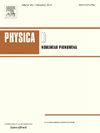Exploring population oscillations: Cross-coupling and dispersal effects in prey–predator dynamics
IF 2.7
3区 数学
Q1 MATHEMATICS, APPLIED
引用次数: 0
Abstract
In this investigation, we explore the dynamics of a predator–prey metapopulation model with two identical patches, emphasizing the coupling mechanism through the predators’ dispersal. The coupling mechanism is a particular case of nearest-neighbor coupling, defined by cross-predation, which depicts the fact that the predators have alternative food resources. The study focuses on how dispersion rates and cross-predation affect species coexistence and system dynamics induced by different kinds of bifurcations associated with periodic orbits and stable states. We examined the structural organization of attractors using bifurcation theory and discovered a variety of intricate dynamics, such as symmetric, asymmetric, boundary, and asynchronous attractors. The onset of synchronous and asynchronous dynamical attractors associated with periodic orbits are analyzed by varying the level of coupling strength and the degree of dispersal rates. Another intriguing phenomenon that occurs in our system is the formation of chaotic attractors with asymmetric dynamics from quasi-periodicity as a result of the Neimark-Sacker (NS) bifurcation. We elucidate the emergence and suppression of chaos using the Poincare return map concept. Our system also exhibits intriguing phenomena, such as bistability and multistability, which indicate that it is capable of preserving ecological diversity and enhancing the level of population persistence. Finally, our findings demonstrate that the system’s dynamics are substantially diverse when the dispersal rate is low with limited coupling strengths. The conclusions have a significant impact on the fields of population and evolution science, improving our knowledge of the complex dynamics found in dispersed ecosystems.
求助全文
约1分钟内获得全文
求助全文
来源期刊

Physica D: Nonlinear Phenomena
物理-物理:数学物理
CiteScore
7.30
自引率
7.50%
发文量
213
审稿时长
65 days
期刊介绍:
Physica D (Nonlinear Phenomena) publishes research and review articles reporting on experimental and theoretical works, techniques and ideas that advance the understanding of nonlinear phenomena. Topics encompass wave motion in physical, chemical and biological systems; physical or biological phenomena governed by nonlinear field equations, including hydrodynamics and turbulence; pattern formation and cooperative phenomena; instability, bifurcations, chaos, and space-time disorder; integrable/Hamiltonian systems; asymptotic analysis and, more generally, mathematical methods for nonlinear systems.
 求助内容:
求助内容: 应助结果提醒方式:
应助结果提醒方式:


